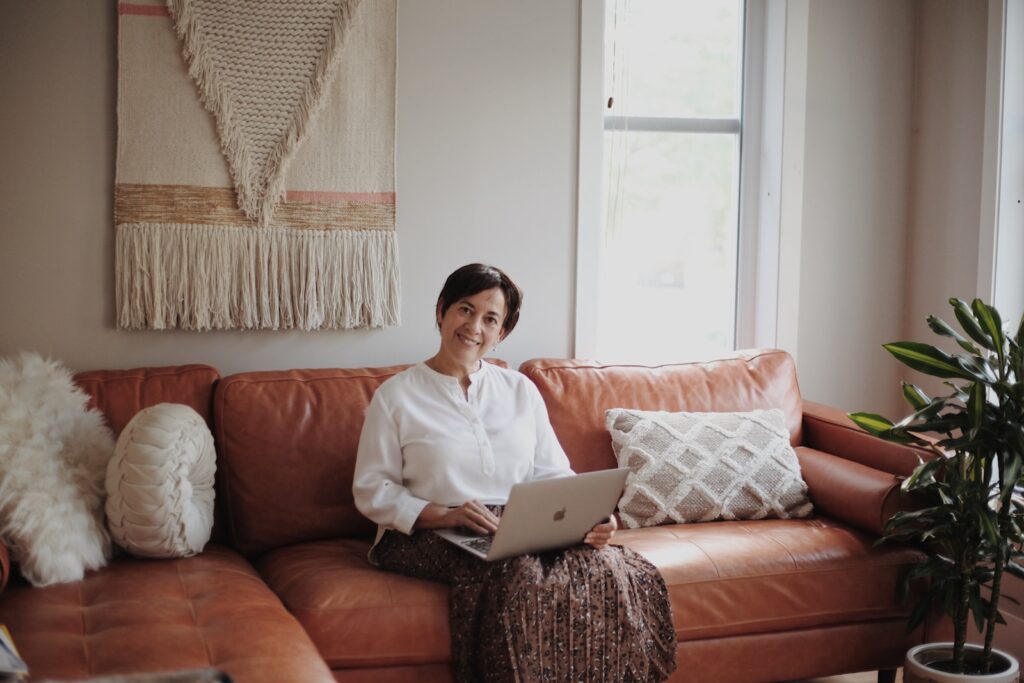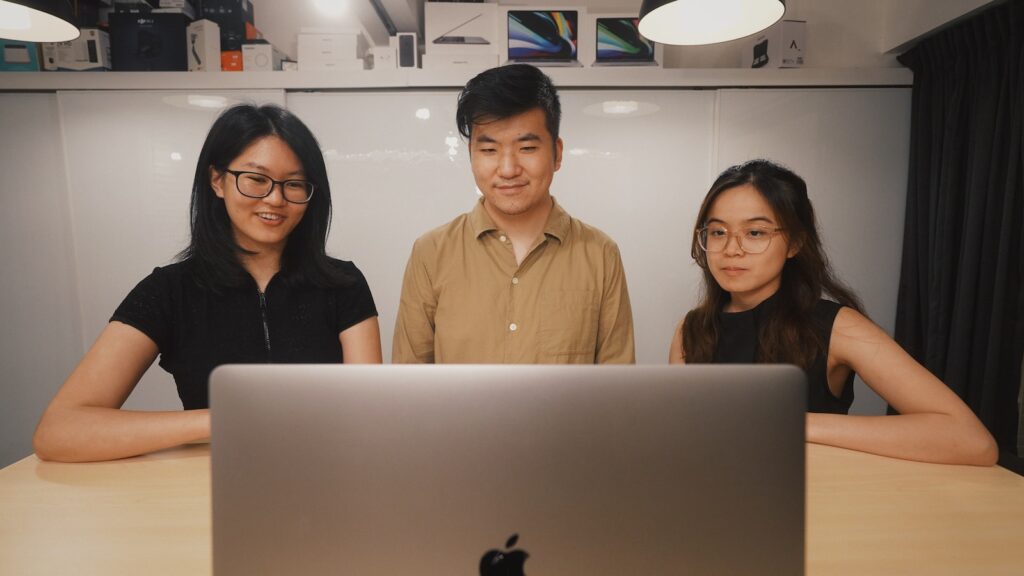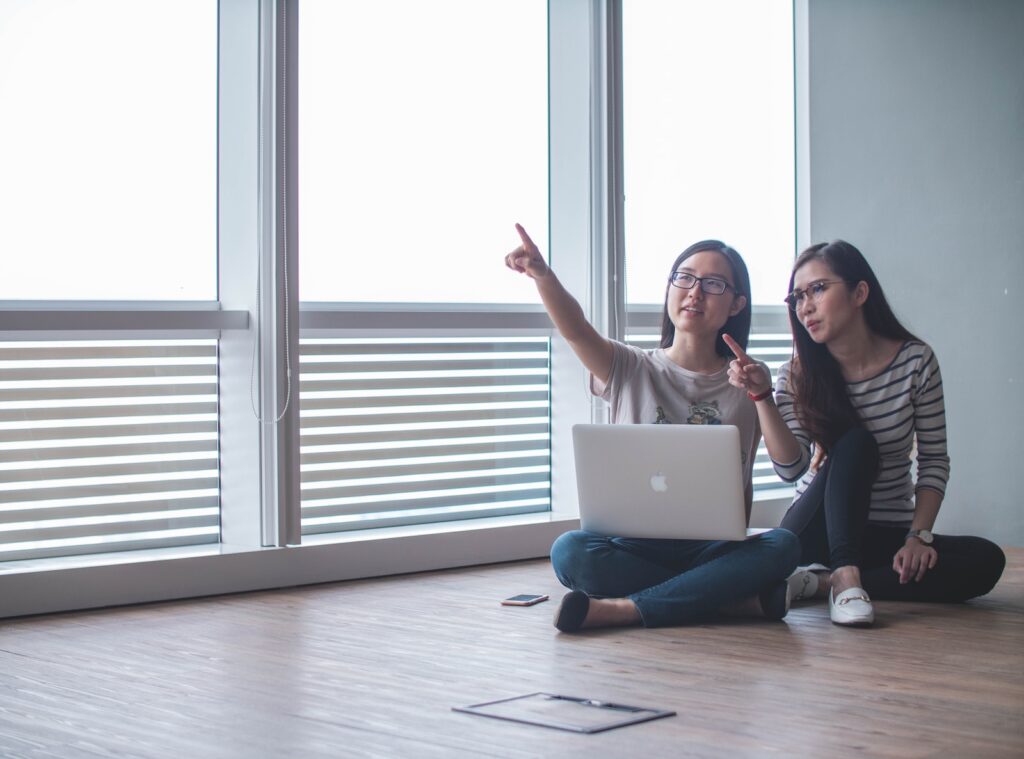Hey there, fellow night owls! Are you tired of browsing the internet with bright white backgrounds that strain your eyes and disrupt your sleep patterns?
Well, fear not. The era of dark-themed websites has arrived, bringing with it a sleek and sophisticated aesthetic that is easy on the eyes and perfect for late-night scrolling.
Dark mode has become increasingly popular in recent years as more users seek a way to reduce eye strain and improve their overall user experience. It’s no longer just an option for tech-savvy enthusiasts; major companies like Apple, Instagram, and Twitter have all implemented dark mode options into their interfaces.
And now, web designers are jumping on board too, creating stunningly beautiful dark-themed websites that provide both style and functionality. So why settle for blinding white screens when you can embrace the darkness and enjoy a more comfortable browsing experience?
The Benefits Of Dark Mode For Your Eyes

Did you know that the average American spends over 11 hours a day looking at screens? That’s more than half of your waking hours!
With so much time spent staring at bright, glowing screens, it’s no surprise that our eyes can become strained and fatigued. This is where dark mode comes in – reducing strain and improving focus for those who spend extended amounts of time on their devices.
By using dark mode, the amount of light emitted by your device is significantly reduced. This means less harsh glare and fewer reflections bouncing off the screen into your eyes.
Dark mode also employs high-contrast text and images against a black or dark background, making it easier to read and therefore requiring less squinting or straining from your eyes.
But what does this mean for you specifically? Less eye strain not only reduces discomfort but can help prevent long-term damage such as blurry vision or headaches caused by prolonged screen use.
Improved focus allows for increased productivity and efficiency when working on digital tasks. So why not give dark mode a try today and see how it benefits your eyes?
The Evolution Of Dark-Themed Design

The evolution of dark-themed design has come a long way since its inception. In the early days, it was seen as an alternative to light themes and was often used by those who preferred something different. However, with the rise of dark mode in recent years, more designers have started to adopt this minimalist approach.
One key feature of dark-themed design is the use of contrast. By using lighter elements against a darker background, text and images can stand out more prominently, creating a visually striking effect. This not only looks great but also helps users focus on what’s important on the website or app they’re using.
Another impact that dark mode has had on user engagement is that it can reduce eye strain for some people. When browsing websites or apps for extended periods, staring at bright white screens can be tiring for the eyes. Dark mode provides a softer visual experience that allows users to stay engaged without hurting their vision.
Here are four reasons why you should consider adopting a dark theme:
1) It creates an instant sense of sophistication and elegance
2) The use of contrast makes it easier for users to read and navigate content
3) It’s less taxing on the eyes during prolonged usage
4) With many devices now offering native support for dark mode, your designs will look even better
In conclusion, we’ve seen how the evolution of dark-themed design has changed over time and become increasingly popular due to its minimalist approach and impact on user engagement. Designers who embrace this trend have experienced increased satisfaction from users while providing them with unique experiences through interesting visuals based upon contrasts between light and darkness. So if you’re looking to create a sleek and engaging website or app, don’t hesitate to try out a dark theme today!
Examples Of Stunning Dark-Themed Websites

Dark-themed websites have become increasingly popular, with more and more designers opting for this style. One reason is the aesthetic appeal of a black or dark background, which can create a sleek and modern look. Additionally, minimalist layouts are often used in conjunction with dark themes to enhance the overall effect.
One standout feature of many dark-themed websites is their use of bold typography. With a darker background, text can stand out even more when it’s large and clear – making it easy to read while still being visually striking. This is especially true when paired with minimalistic design elements that allow the typography to take center stage.
Overall, there are countless examples of stunning dark-themed websites out there today. Whether you’re looking for inspiration or just appreciate the unique beauty of this style, there’s no denying its growing popularity among web designers.
So if you’re thinking about incorporating a darker theme into your next project, don’t be afraid to experiment with minimalist layouts and bold typography – who knows what kind of amazing results you might achieve!
How To Implement Dark Mode On Your Website

Sticking to a consistent design is crucial in creating a visually appealing and user-friendly website. When considering the implementation of dark mode, it’s important to maintain this consistency throughout all pages and features. By doing so, users are less likely to become disoriented or confused while navigating your site.
In addition to maintaining design consistency, dark mode also has the potential to increase user engagement on your website. Studies have shown that individuals spend more time on websites with darker backgrounds compared to those with lighter ones. This increased engagement can lead to higher conversion rates and ultimately contribute positively towards your business goals.
When implementing dark mode on your website, there are several factors you should consider such as accessibility for individuals with visual impairments and ensuring readability of text against contrasting backgrounds. By taking these precautions, you’ll be able to create an engaging and accessible experience for all users regardless of their preferences or needs.
The Psychology Of Dark-Themed Design

Dark-themed websites have become increasingly popular in recent years, with many users preferring the sleek and sophisticated look that they offer. However, there is more to dark mode than just aesthetics. Color psychology plays a significant role in user experience when it comes to design.
Research has shown that colors can influence our emotions and behavior. Darker shades of color are associated with feelings of sophistication, elegance, and mystery. This is why many luxury brands opt for darker-colored logos and designs.
In terms of website design, using dark colors can create an atmosphere of exclusivity and professionalism. However, it’s important to note that not all users prefer dark themes. Some find them difficult to read or navigate, while others may associate them with negative emotions such as sadness or fear. As such, designers should consider their target audience before implementing a dark theme on their website.
Ultimately, the goal of any good design is to enhance the user experience – whether through light or dark themes.
Four ways incorporating color psychology into your dark-themed design can improve user experience:
- Use contrasting text colors for readability
- Employ accent colors strategically to highlight important content
- Consider cultural associations with certain colors
- Conduct A/B testing to determine which color schemes work best for your specific audience
Designing a website requires careful consideration of both aesthetics and functionality. For those who choose to go down the path of a darker theme, understanding how color psychology influences user experience is crucial. By utilizing this knowledge effectively alongside modern web development techniques like responsive layouts & typography optimization you will be able to craft stunningly beautiful sites optimized for maximum usability- no matter what kind of screen size people use!
Dark Mode Vs. Light Mode: Which Is Better?

Dark mode has become increasingly popular on websites, but is it really better than light mode?
There’re pros and cons to both – dark mode offers a more modern look and can be easier on the eyes at night, but can make it harder to read text and see images.
Design-wise, dark mode can add a sleek look to a site, and can be used to draw attention to call to action buttons. On the other hand, light mode can make it easier to read text and see images, and can offer an airy and open feel to a webpage.
User experience wise, dark mode might be more comfortable for night-time browsing, while light mode might be more suitable for day-time viewing.
Ultimately, it depends on the user’s preference.
Advantages/Disadvantages
So, you’re wondering whether dark mode or light mode is the way to go for your website? Let’s weigh up the pros and cons.
Dark mode has become increasingly popular in recent years due to its sleek look and reduced strain on the eyes. With user preferences shifting towards darker themes, implementing a dark mode option on your website could improve overall user experience.
One of the main advantages of dark mode is that it reduces eye fatigue caused by blue light emitted from screens. This can be particularly beneficial for users who spend long periods of time browsing online. Additionally, dark backgrounds make text stand out more, making reading easier and improving overall readability.
However, one potential drawback of using a dark theme is that it may not suit all types of content equally well – some images and videos may not display as well on a black background compared to white.
Ultimately, when deciding between dark mode or light mode for your website, it comes down to understanding your audience’s preferences. While studies have shown that younger generations tend to favor darker modes, older audiences may prefer traditional lighter themes. Consider conducting surveys or A/B testing with different groups to determine which one resonates better with your target market.
By doing so, you’ll create an optimal user experience while also staying current with design trends.
Design Impact
As a dark mode content writer, it’s important to consider the impact of design when choosing between light and dark modes.
While dark backgrounds can create an elegant and modern look, contrast considerations should be taken into account. Brightly colored text or images may not stand out as well on a black background compared to white, which could lead to reduced readability.
Another crucial aspect is accessibility concerns. Dark mode might not be suitable for users with visual impairments who rely on high-contrast settings to navigate websites.
It’s essential to ensure that your website remains accessible for everyone by providing options for both light and dark themes.
In summary, while dark mode has its advantages in terms of reducing eye strain and improving reading comfort, designers must also weigh up the potential drawbacks such as contrast issues and accessibility concerns.
By offering both light and dark modes, you can provide a user-friendly experience that meets the needs of all visitors to your site.
User Experience
As a dark mode content writer, I understand the importance of creating an excellent user experience. When it comes to designing for dark mode, one crucial consideration is the impact of color on user experience.
Colors that work well in light backgrounds may not be as effective in dark environments. If you’re using text or images with bright colors, they may not stand out as much against a black background compared to white.
To ensure that your website remains accessible and user-friendly for everyone, it’s essential to follow best practices for designing for accessibility in dark mode. This includes providing high-contrast options for users with visual impairments who rely on these settings to navigate websites. It also means ensuring that all text is legible and easy to read by choosing appropriate fonts and font sizes.
In conclusion, while dark mode can provide many benefits in terms of reducing eye strain and improving reading comfort, designers must consider both its advantages and potential drawbacks when deciding between light and dark modes. By following best practices for accessibility and considering the impact of color on user experience, we can create a seamless transition between both themes, ensuring that our site visitors have an enjoyable experience regardless of their preference.
The Future Of Dark-Themed Websites And Design Trends

As we’ve previously discussed, the debate between dark mode and light mode has been a hot topic for some time now. However, it seems that the tides have turned in favor of darker themes.
In fact, according to recent studies, there has been a 180% increase in searches related to ‘dark mode’ over the past year alone. This rise in popularity can largely be attributed to user preferences. More and more people are seeking out ways to reduce eye strain and improve their overall browsing experience, which is where dark-themed websites come into play.
Design implications also play a role – with advancements in technology allowing for better screen contrast ratios, designers are able to create stunning visuals that really pop against darker backgrounds. Moving forward, we can expect to see even more innovation in the realm of dark-themed design.
From bold color choices to intricate patterns and textures, designers will continue pushing boundaries and finding new ways to make these sites stand out from traditional white or bright-colored layouts. As users become increasingly accustomed to this style of browsing, we may even reach a point where it becomes the norm rather than the exception.
Key Takeaways
- Dark-themed websites have gained popularity due to their sleek and sophisticated aesthetic, providing a comfortable browsing experience.
- Dark mode reduces eye strain and fatigue by reducing the amount of light emitted from the device.
- Dark-themed design emphasizes contrast, making text and images stand out more prominently.
- Implementing dark mode can improve user engagement and increase productivity.
- Color psychology plays a role in the user experience of dark-themed websites, evoking feelings of sophistication and elegance.
- Designers should consider their target audience’s preferences and conduct A/B testing when implementing dark mode.
- Dark mode and light mode have their own advantages and disadvantages, and the choice depends on user preference and content suitability.
- Designers should consider contrast, accessibility, and readability when choosing between light and dark modes.
- Providing options for both light and dark themes ensures a user-friendly experience for all visitors.
- The future of dark-themed websites suggests continued growth and innovation in design trends, with more advancements and creative possibilities.
Useful Table: Dark Mode vs. Light Mode
| Dark Mode | Light Mode |
|---|---|
| Offers a modern and sleek look | Provides an airy and open feel |
| Reduces eye fatigue caused by blue light | Offers easier readability and image visibility |
| Makes text stand out, improving readability | May not display certain content as effectively |
| Can draw attention to call-to-action buttons | Offers a more traditional and familiar design |
| More suitable for night-time browsing | More suitable for day-time viewing |
| Preferred by younger generations | Preferred by older audiences |
Frequently Asked Questions
Why is dark mode becoming increasingly popular?
Dark mode is popular because it reduces eye strain and improves the overall user experience. It provides a sleek and sophisticated aesthetic that is easy on the eyes, especially during nighttime browsing. Major companies like Apple, Instagram, and Twitter have implemented dark mode options into their interfaces, contributing to its popularity.
What are the benefits of dark mode for your eyes?
Dark mode reduces eye strain by significantly reducing the amount of light emitted by your device. It minimizes harsh glare and reflections, making it easier on the eyes. The high-contrast text and images against a dark background also enhance readability, reducing the need for squinting or straining. Using dark mode can help prevent long-term eye damage and improve focus, leading to increased productivity and efficiency.
How has dark-themed design evolved over time?
Dark-themed design has evolved from being an alternative to light themes to a popular minimalist approach. It uses contrast to make text and images stand out more prominently, creating a visually striking effect. Dark mode reduces eye strain, allowing users to stay engaged without hurting their vision. With native support for dark mode on many devices, designers can create even better designs.
What impact does color psychology have on dark-themed design?
Color psychology plays a significant role in user experience when it comes to design. Dark colors are associated with sophistication, elegance, and mystery. They create an atmosphere of exclusivity and professionalism. However, designers should consider their target audience’s preferences and associations with colors before implementing a dark theme. Understanding color psychology can help designers create engaging experiences by using contrasting text colors, accent colors strategically, considering cultural associations, and conducting A/B testing.
Is dark mode better than light mode?
Whether dark mode or light mode is better depends on user preference. Dark mode offers a modern look and can be easier on the eyes at night, but it may make it harder to read text and see images. Light mode makes reading and viewing images easier, offering an airy and open feel. Consider user preferences, conduct surveys, or perform A/B testing to determine which mode resonates better with your target audience. Providing options for both modes can ensure an optimal user experience.
Final Thoughts
As a dark mode content writer, I can attest to the growing trend of dark-themed websites. Not only do they look sleek and modern, but they also provide numerous benefits for our eyes. The evolution of design has brought us to this point where we can embrace the darker side of things.
Take a look at some stunning examples of dark-themed websites, like Spotify or Apple’s website. These designs are not only visually appealing but provide users with an immersive experience that draws them in.
As we move forward, it’s clear that dark mode will continue to be a popular choice for designers and developers alike. The future is looking bright (or should I say, dark?). With more research being conducted on how color affects our perception and behavior, we may see even more benefits emerge from using darker themes.
So why not embrace the darkness and implement it into your own website? Your viewers’ eyes will thank you.

